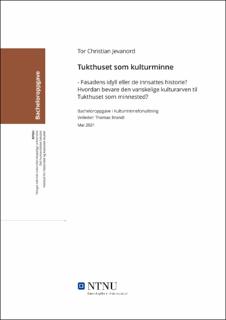| dc.contributor.advisor | Brandt,Thomas | |
| dc.contributor.author | Jevanord, Tor Christian | |
| dc.date.accessioned | 2021-09-13T16:13:46Z | |
| dc.date.available | 2021-09-13T16:13:46Z | |
| dc.date.issued | 2021 | |
| dc.identifier | no.ntnu:inspera:80492741:35272650 | |
| dc.identifier.uri | https://hdl.handle.net/11250/2775873 | |
| dc.description.abstract | Fasadens idyll eller de innsattes historie? Første inntrykk av et kulturhistorisk bygg er som oftest fasaden. Man vurderer den arkitekturiske stilen, om den passer den inn i det kulturhistoriske miljøet og funksjonen til bygget. Hva er bak fasaden, er de innsattes historie ivaretatt. Oppgaven skal gi et svar på problemstilling: Hvordan bevare den vanskelige kulturarven til Tukthuset som minnested? For å besvare problemstillingen er utgangspunkt i historiene om enkeltindividene, hvilken kulturarv anlegget består av og satt det opp mot relevant teori innen kulturminneforvaltning. Hvem er det som eier bygget og hva de eventuelt ønsker å formidle med historien om Tukthuset.
Den metodiske fremgangsmåten er å undersøke teori om verdisetting og historikken til Tukthuset, samt intervjue dagens eiere av Tukthuset. De innsattes historie er konsentrert mot de kvinnelige fangene, med utgangspunkt de som var med i Kautokeino-oppgjøret og de som fødte i dølgsmål. Ved å ta utgangspunktet i historien de kvinnelige innsatte, kan man finne mere ut om rettshistorien og på den andre siden få innsikt i hvordan det var å sitte inne på Tukthuset. | |
| dc.description.abstract | The idyll of the façade or the history of the Prisoners? The first impression of a cultural-historical building is usually the façade. One considers the architectural style, whether it fits it into the cultural-historical environment and function of the building. What is behind the façade, the history of the Prisoners is taken care of. These should provide an answer to the problem: How to preserve the difficult cultural heritage of the Tukthuset as a memorial? To answer the problem is based on the stories of the individuals, what cultural heritage the facility consists of and set it up to relevant theory in cultural heritage management. Who owns the building and what they might want to convey with the story of Tukthuset.
The methodological procedure is to examine the theory of valuation and the history of the House of Tukthuset, as well as interview the current owners of The Tukthuset. The inmates' history is concentrated against the female prisoners, based on those who took part in the Kautokeino settlement and those who gave birth in baptisms. By starting from the story the female inmates, one can find out more about the legal history and on the other hand gain insight into what it was like to sit inside the Tukthuset. | |
| dc.language | nob | |
| dc.publisher | NTNU | |
| dc.title | Tukthuset som kulturminne
- Fasadens idyll eller de innsattes historie? Hvordan bevare den vanskelige kulturarven til Tukthuset som minnested? | |
| dc.type | Bachelor thesis | |
